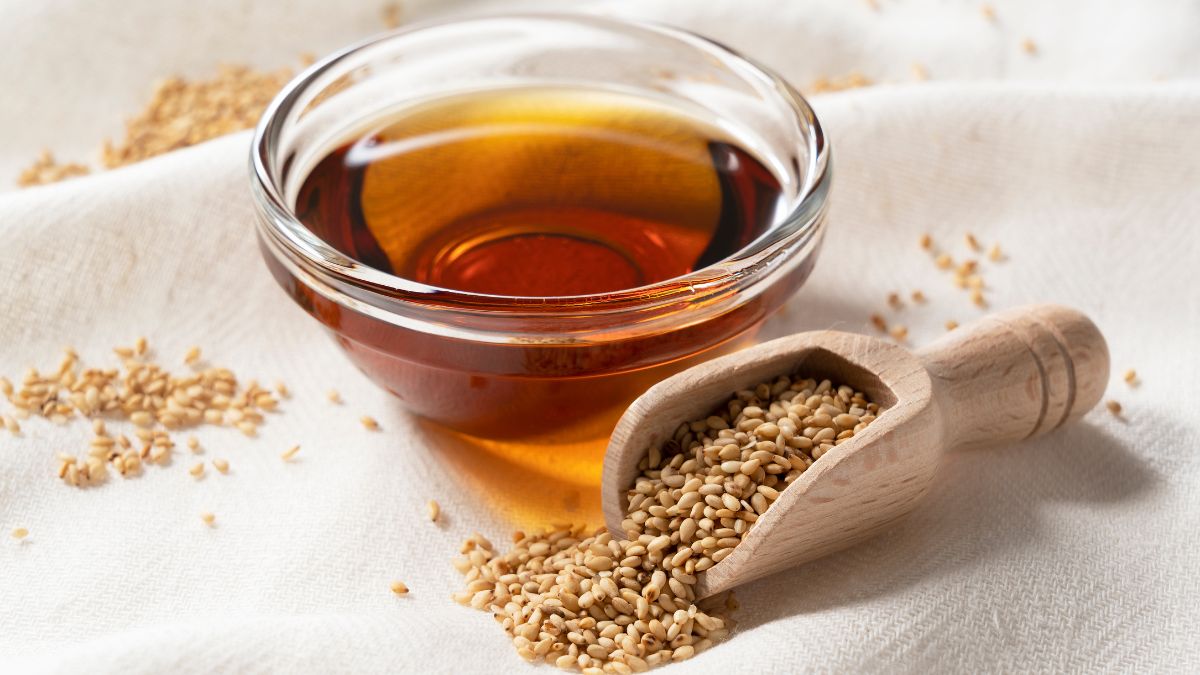Answer: Yes. Sesame Oil is sourced from sesame seeds and is suitable for a vegan diet.

One of my favorite oil dressings for my salad is Sesame Oil because of its rich nutty taste that adds to the salad’s already flavorful burst.
Sesame oil, derived from either raw or toasted sesame seeds, is a versatile and flavorful addition to many dishes. While toasted sesame oil offers a rich, nutty aroma prized in Asian cuisine, it’s best enjoyed as a finishing oil rather than for frying. Not only is sesame oil celebrated for its distinctive taste, but it is also completely vegan, making it an excellent choice for plant-based diets in 2025 and beyond. Often referred to as the “Queen of Oilseeds,” sesame oil continues to be a staple for cooking enthusiasts worldwide.
Let’s go find out more about Sesame Oil in this article!
What Is Sesame Oil?
Sesame Oil is derived from ripened sesame seeds, which undergo a process for extraction. The seeds are the edible fruit of the sesame plant, also called benne.
These seeds grow in pods in the plant itself that are usually harvested by hand and are placed in an upright position until they’re fully ripened.
The sesame plant’s origins can be dated 3,000 to 5,000 years ago in the southern part of the Sahara Desert in Africa. The seed is among the oldest oilseed crops known in history.
Another variety is known to have been first cultivated in India or during the Indus Valley civilization in South Asia.
Sesame is from the Latin word Sesamum and the Greek word Sēsamon, meaning “oil, liquid fat.”
Sesame’s English word benne was first used in 1769, derived from the creole folk language Gullah.
The Gullah people were African-American settlers in the coastal regions of Georgia and South Carolina. They’re also found in northeast Florida and southeast North Carolina.
Sesame is known for its ability to grow in areas most plants can’t. It can grow in extreme heat, which makes it a survivor crop.
Sesame Oil consists of different fatty acids, with linoleic acid being the highest at around 40%.
Oleic acid is also present in sesame oil, palmitic acid, and stearic acid.
On the other hand, Tanzania is the largest Sesame Oil producer in the world and is also dominating in global consumption alongside Asia and the rest of the African regions.
Sesame Oil is also widely used in cosmetics, soaps, lubricants, paints, and other industrial purposes.
In religion, Sesame Oil is used during rituals in Mandaeism, both in baptism and death mass.
The Process
Sesame Oil can be cold-pressed, roasted, or unroasted.
Like many other vegetable oils, it’s sold as virgin oil or unrefined, which many consumers prefer. Refined sesame oil goes through extraction, neutralization, and bleaching.
Here’s how Sesame Oil is processed in the factory.
- Cleaning. Seed cleaning equipment removes unnecessary debris like stones and dust and sorts out the good seeds for production.
- Dry Roasting. Cleaned sesame seeds are cooked by heating them until they’re roasted, which makes them dry and ready for pressing.
- Pressing. A Sesame Oil Expeller is used to press or crush the dried or roasted seeds to extract the oil. Once the oil is extracted, it takes up to two to four days to settle before it goes through the filtration process.
- Filtration. As soon as the oil is settled, there will be residue, oil cakes, and other impurities that need to be removed. This is the purpose of the filtration process.
- Refining. Refined Sesame Oil undergoes this process, which involves chemical treatment to eliminate any impurities and odor. This involves solvent extraction, neutralization, and bleaching. Also, this would result in a clearer appearance of the oil.
- Packing. As soon as the oil is done with all these processes, it’s now ready for packing, which is distributed to the market.
Many consumers prefer using unrefined Sesame Oil as it retains more nutrients than its refined counterpart.
It’s processed under low temperatures, which also doesn’t increase the toxicity of fatty acids in the oil.
Extra Virgin Sesame Oil is produced from the first cold-pressed process and is not heated excessively. This creates a powerful aroma and is not recommended for deep frying as it can overpower the food itself.
Also, it looks darker and cloudy, with a nuttier and sweeter taste.
Refined Sesame Oil loses its important nutrients because it’s chemically treated. This involves hexane, sodium hydroxide, bleach, and chemical deodorants.
Most refined Sesame Oil is pale in appearance and offers the same neutral taste.
Pressed raw sesame seeds produce cold-pressed oil, which is great for cooking. Toasted sesame seeds produce a more aromatic and nutty oil and are suitable for seasoning.
Sesame Oil Is Vegan and Environmentally Friendly
The sesame plant, its seeds, and the process of producing Sesame Oil don’t involve animal by-products.
For this reason, Sesame Oil is vegan and is great for vegan cooking and other dishes.
It’s also moderately sustainable as it doesn’t leave a huge impact on the environment, especially since the crop is known as drought-tolerant.
But it’s always recommended to use organic or non-GMO Sesame Oil.
This means that the plant is free from pesticides and herbicides, which contaminate the air, water, land, and forest.
So if you went vegan for environmental reasons, Sesame Oil is your best bet.
How Healthy Is Sesame Oil?
Sesame Oil is also known for its rancidity resistance and is considered one of the most stable oils. Because the sesame plant can grow even in areas under drought conditions, Sesame Oil is considered the Queen of Oilseeds.
It’s rich in protein, fats, fiber, and some minerals that help improve the overall health of humans.
Here are the top health benefits of Sesame Oil.
- Sesame Oil is loaded with antioxidants. Both powerful antioxidants, called sesamol and sesaminol, reduce the risk of cell damage brought about by free radicals.
- Its strong anti-inflammatory properties are also known to fight against chronic inflammation.
- Sesame Oil is also rich in monounsaturated fats (MUFA), which reduce the risk of many heart diseases. It’s worth noting that Sesame Oil contains around 85% of unsaturated fats that are good for the heart.
- It can also help regulate blood sugar levels, especially for those suffering from diabetes.
- A few studies also suggest that using Sesame Oil regularly can help treat arthritis and oxidative stress.
- Because of its antioxidants and anti-inflammatory properties, Sesame Oil can also help cure wounds and burns as a topical medicine. Ozonated Sesame Oil can also increase collagen levels in wound tissue, which are valuable in wound healing.
- Sesame Oil can also protect the human skin against damaging UV rays, resisting at least 30% harmful effects. It can also be a good source of natural sunscreen.
- Regular Sesame Oil consumption can also help improve sleep quality, relieve arm and leg pains, and is good for hair health.
Sesame Oil is good for overall health, but it can also cause allergic reactions, especially in those allergic to nuts and seeds. It rarely happens, but if you are, it’s best not to use Sesame Oil.
Best Sesame Oil Brands to Try
I have tried a few brands of Sesame Oil that I bought from the supermarket, and I can say that they’re all good. However, I always prefer organic brands, especially since they’re made from sesame seeds free from pesticides and herbicides.
So if you’re curious about which brand to use, check this list.
- Napa Valley Naturals Cold-Pressed Sesame Oil
- Flora Organic Cold-Pressed
- Foods Alive Organic Cold-Pressed
- Chose Foods Spicy Unrefined Sesame Oil
- 365 Everyday Value Organic Sesame Oil
- Kevala
- Hain Pure Foods Sesame Oil
- Holy Natural Organic Unrefined Sesame Oil
You can try many brands and see which one you prefer the most. Look for organic, raw, or unrefined labels if you want to try a healthier Sesame Oil.
Types of Sesame Oil for Cooking
Apart from the brands of Sesame Oil that you may need to know, you should also check what type you should get for cooking.
- Unrefined Sesame Oil. It has a low smoking point. and is best for salad dressing or to top off many dishes.
- Refined. It has a neutral taste with a high smoking point, which is best for deep frying.
- Blended. This is mixed with other vegetable oil such as corn and soybean.
- Light. It’s made from raw, untoasted sesame seeds with a mild flavor and is great for seasoning.
- Roasted. Its appearance is lighter in color with a milder taste.
- Cold-Pressed. This doesn’t go through extreme heat and chemical treatment, making it healthier than others.
- Toasted. It has a powerful aroma since it’s made from toasted sesame seeds. It’s best for finishing cooking and is popular in Asian cuisine.
The Bottom Line
Sesame Oil is vegan and is considered the Queen of Oilseeds because of its resistance to rancidity and high tolerance to a drought of the sesame plant.
It’s also good for overall human health and doesn’t leave huge damage to the environment during its production.
But there are other vegan-friendly cooking oils you can also try, such as Soybean Oil or Olive Oil, which I detailed in this article.
Lastly, it’s best to get organic Sesame Oil as it’s healthier and good for mother nature!




